What can you make with garlic scapes and bolted onions from your garden or market? Here are some great ideas and a bonus pesto recipe.
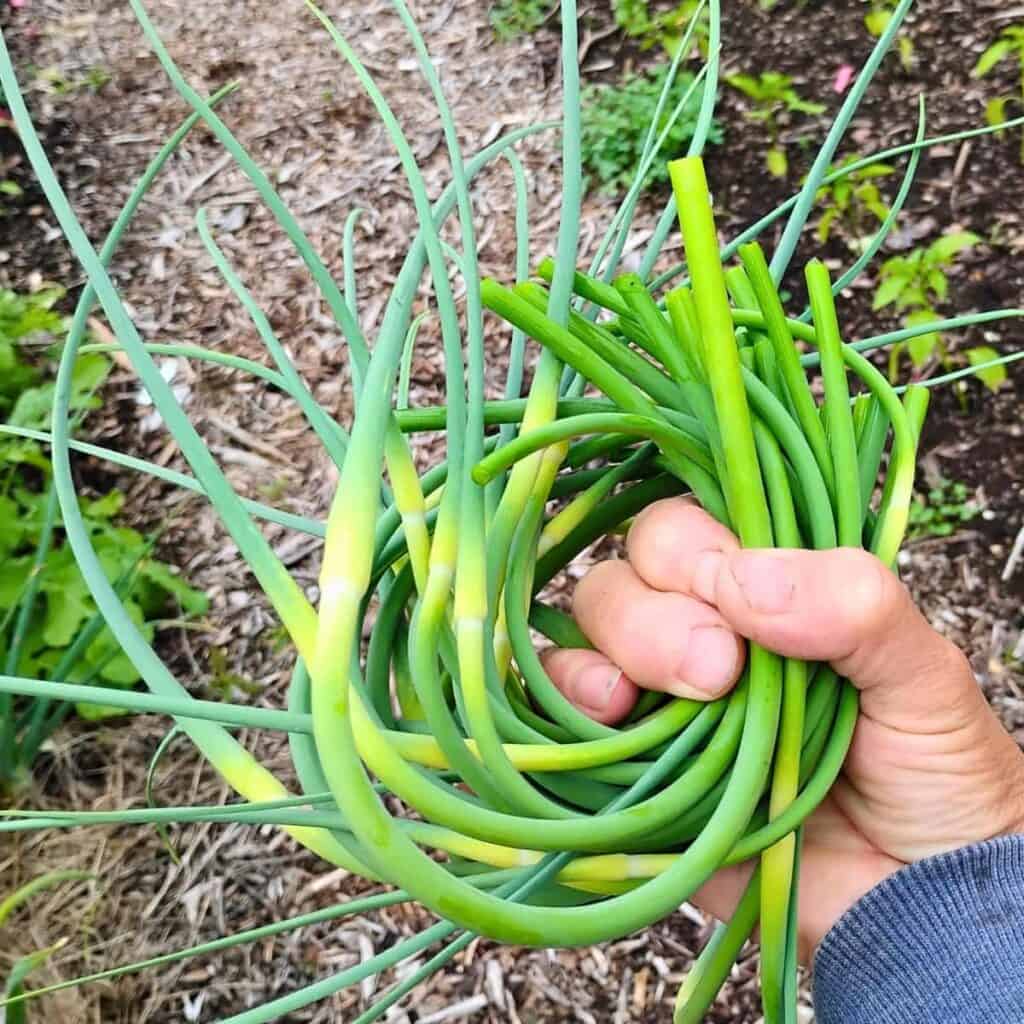
This post contains affiliate links. As an Amazon affiliate, I make a small commission at no extra cost to you if you make a qualifying purchase. See my full disclosure here.
When you find that your garlic plants are sending up curly flower stalks, you’ll need to break them off so the garlic will put its energy into growing bigger bulbs instead of growing seed. When onions bolt, they are done making bulbs and you need to use them soon.
Don’t toss these tasty veggies! Read on to learn how to harvest garlic scapes and onion greens and flower stalks and find great ideas for using them. Discover how you can turn these ‘discards’ from the garden into delicious meals. And I’ll share my favorite recipe, a superb garlic scape and onion greens pesto below!
If you love garlic, learn how to grow your own garlic here. And you can get my tutorial on how to grow onions from seeds. If you love pesto, you’ll have to try my wild greens pesto from foraged greens and weeds. Super tasty! And you can get my recipe for fermenting garlic scapes here.
- How To Use Garlic Scapes And Onion Flower Stalks
- What are Garlic Scapes?
- Bolted Onion Or Shallot Flower Stalks and Leaves
- How To Use bolted Onion Flower Stalks and leaves
- Garlic Scape And Bolted Onion Greens Pesto Recipe
- How to use the pesto
- Enjoy Your Abundant Harvest Of Garlic Scapes and Embrace The Unfortunate Event Of Your Bolted Onions!
- Other recipes you might like
- Pin This Post
- Shop This Post
How To Use Garlic Scapes And Onion Flower Stalks
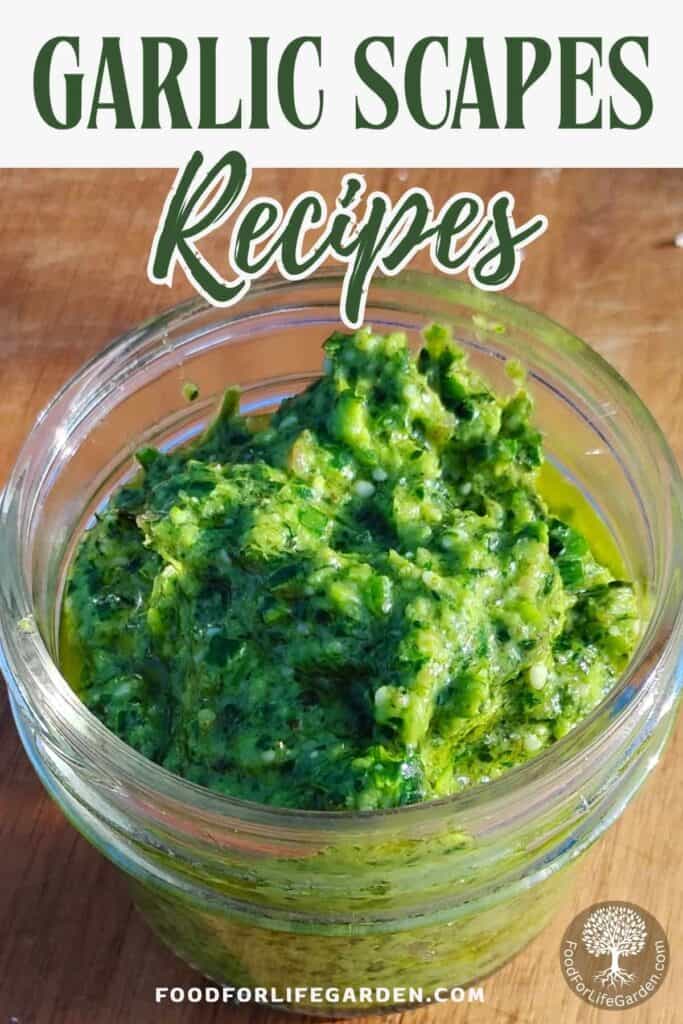
I’ve gathered a few ideas here about what to do with garlic scapes and onion flower stalks. But first let’s find out what we’re dealing with here.
What are Garlic Scapes?

When you grow hardneck garlic, it has the habit of sending up flower stalks, called scapes, a few weeks before it is garlic harvesting time. If you don’t pick them, your garlic bulbs will stop growing and will not be good for storage. So these garlic scapes will need to be snapped off at the base to force the garlic to put its energy into growing nice, big garlic bulbs for your storage bin.
If you do forget one (which is easy to do), it will make a flower that produces tiny bulbils, like tiny garlic cloves. These can be planted, but it will take several years of replanting before you get good sized garlic bulbs from it. It can be a fun project to try, but it’s not as efficient as replanting your nicest garlic cloves in the fall.
Learn more about how to grow garlic.
How to harvest garlic scapes
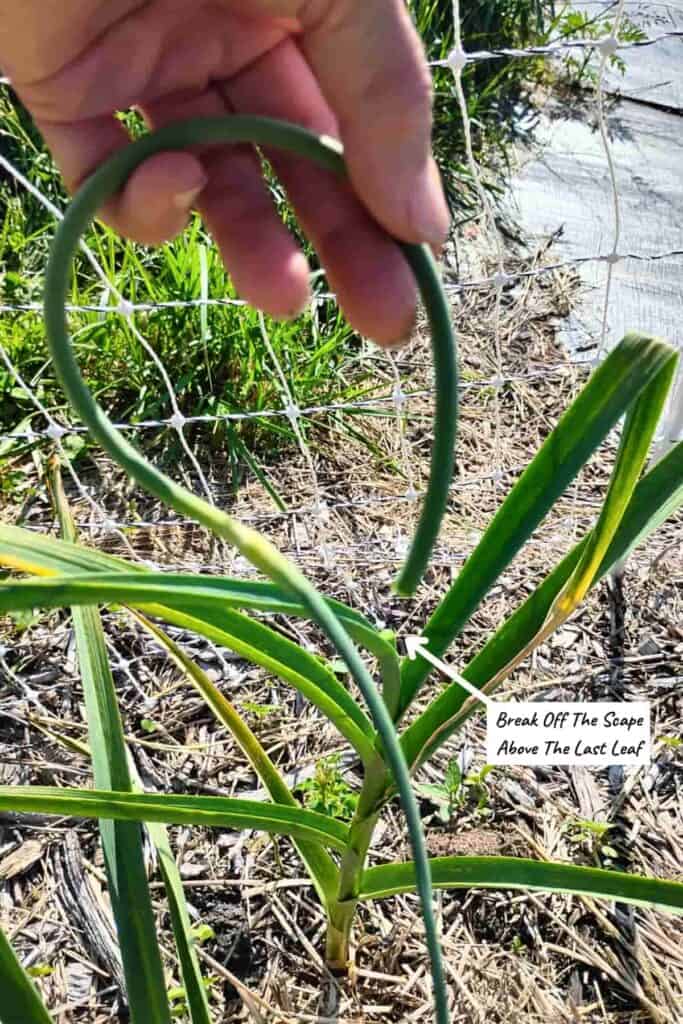
Garlic scapes are nice and tender for a short time, pick them just as they start to curl up. After that they turn woody and won’t be good for cooking, however, they can still be used to make a tasty soup stock or bone broth. I toss mine in a freezerbag along with other kitchen ‘discards’ like onion peels and parsley stalks. Then I just put them in the freezer beside a collection of chicken or pork bones to use when I want to make a bone broth.

Before using garlic scapes in any recipe, all you need to do is chop off that fiber-rich spike at the end of the flower. It’s too tough for these recipes, however, they can be saved in your ‘discard’ freezer bag and used in your next bone broth or soup stock.
You can store fresh garlic scapes for about a week in a plastic bag or a veggie bag.
How to use Garlic Scapes
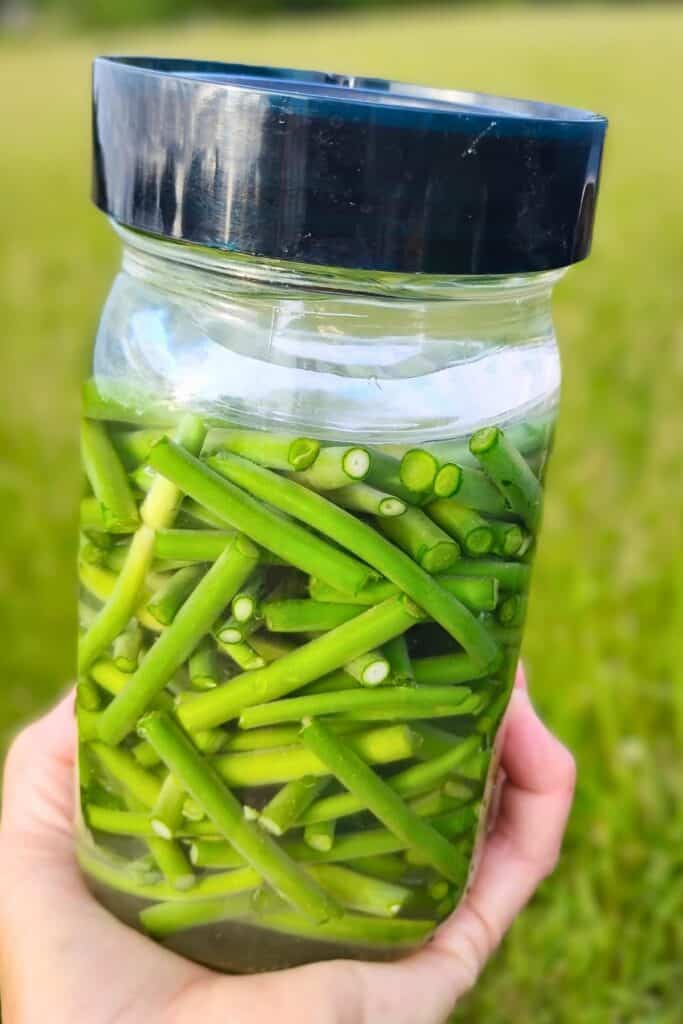
Let me tell you, garlic scapes are delicious and are great to use in place of garlic in recipes. A nice way to hold you over till your crop of garlic bulbs is ready to harvest. They are more mellow than the garlic cloves, but have plenty of garlic flavor.
- Use them in stir-fries. Chop into bite sized pieces and stir fry with other vegetables. Use in any stir fry recipes.
- Sautee as a delicious side dish. They remind me of green beans or asparagus with a mild garlicky flavor. Super delicious just sauteed in butter and/or olive oil for a few minutes. Lightly salt, then cover the pan for a few more minutes with a splash of water added if necessary. Serve plain or with a creamy holandaise, lemon, or just a blob of mayo. Super delicious.
- Grill your Scapes, just coat with olive oil, lightly salt and pepper, grill until browned and soft inside.
- Chop finely and use raw just like chives in salads.
- Top baked potatoes with sourcream and thinly sliced garlic scapes.
- Mix with Quark, Chevre, blended queso fresco, Cottage cheese, Sour cream, or Mayonnaise for a tasty dip or a spread for sandwiches. I love to use my chevre or salted quark and mix it with parsley, cilantro, hot sauce or cayenne pepper, and garlic scapes to top my toasted sourdough bread.
- Make an oil infusion by submerging a handful of the chopped or sliced scapes in a pint of olive oil. The following step helps but is not neccessary: Warm the oil and scapes a little for 20 minutes, just to about 90 degrees or so, to facilitate with the infusion process. Be sure to refrigerate it afterwards to prevent growth of bacteria, and keep it refrigerated.
You can keep the scapes in the oil or strain it off. Use the oil to drizzle over bread (I’m thinking ciabatta with a slice of cheese) or drizzle over baked potatoes, vegetables, or salads.
- Make a herbal vinegar by filling a jar half way with chopped garlic scapes or slice them lengthwise so it looks pretty. Then top it off with Apple cider vinegar. This should macerate for several weeks, and will yield a flavored vinegar you can use in culinary recipes.
For example, you can use it in salad dressings, drizzle it over salads with some olive oil, or use as an ingredient in dips. But it makes great medicine too. You can mix some with a little water and drink a shot of it daily. Garlic can help prevent colds and strengthen the immune system. Learn more about the many health benefits of garlic in fermented garlic paste and fermented garlic and honey.
- You can chop them and use them in soups and stews like beans.
- Make a delicious pesto by using garlic scapes in any pesto recipe. Use about ⅔ herbs to ⅓ garlic scapes for a ratio or you’ll have a pesto that’s a bit overpoweringly garlicky. I’ll provide a recipe for my version below!
- Make a garlic scape butter by chopping the garlic scapes finely and adding it to softened butter. Refrigerate before serving. Great to serve with meat and try with any recipes that use compound butter.
- Garlic scapes are great in any egg dish too. Add chopped scapes to a quiche, include in a frittata, sprinkle over scrambled eggs or saute first and then add your scrambled eggs, or make an omelet.
- Freeze them! Chop into serving size pieces and just throw them into a freezer bag or container and freeze. Easy and quick. When you need them, take out a handful and add them to your soup, stew or other cooked dish.
- Dehydrate the garlic scapes. Then grind into a powder to use as a seasoning.
- Pickle them! I don’t have a pickling recipe to share, but you can try pickling them like dilly beans in vinegar and can them. I prefer fermenting to pickling and I do have a recipe for that.
- Ferment them! Garlic scapes are easy to ferment, then refrigerate or store in a cold cellar.
They will be good for at least a year and are a delicious addition to fresh green salads, creamy potato salad, or as a side with any dish. They will taste very mildly garlicky, more of an aftertaste. They are great as a tangy snack too!
Use the fermentation brine to flavor the mayonnaise for your potato salad or macaroni salad, use as a base for other salad dressings, or drink a shot as a tonic. If you’re new to fermenting, check out my detailed tutorial on fermenting vegetables for more information and the master recipe for brine fermentation.
Bolted Onion Or Shallot Flower Stalks and Leaves
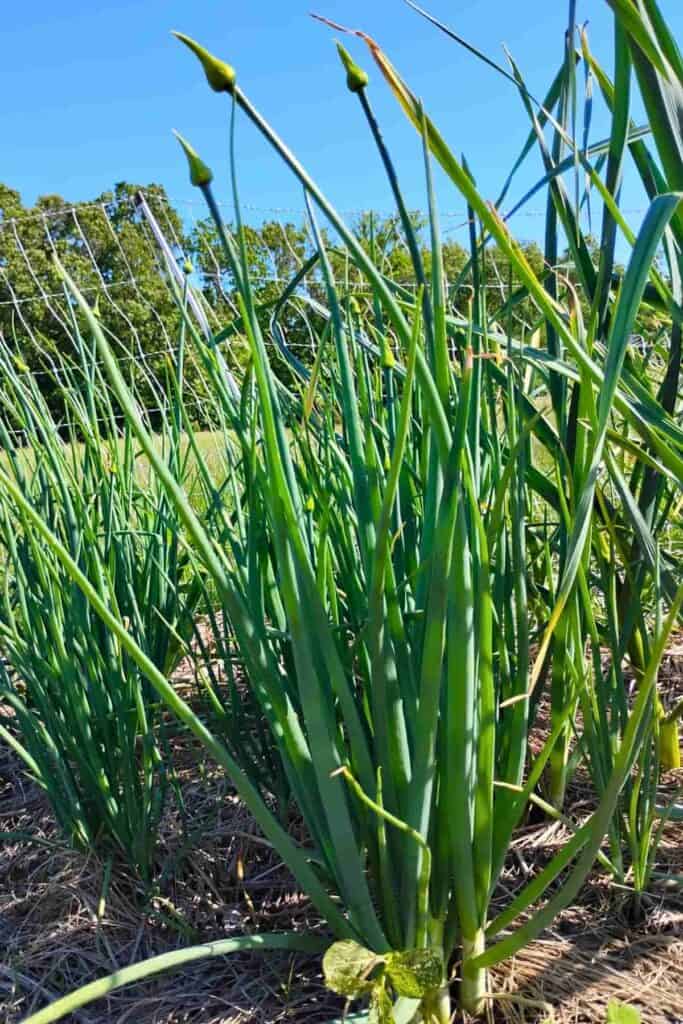
Onions and Shallots are biennial, which means they grow in year one and bolt (try to make seeds by producing flowers) in year two. However there is a caveat. There are times when onions, or shallots, can bolt prematurely.
Why onions or Shallots bolt
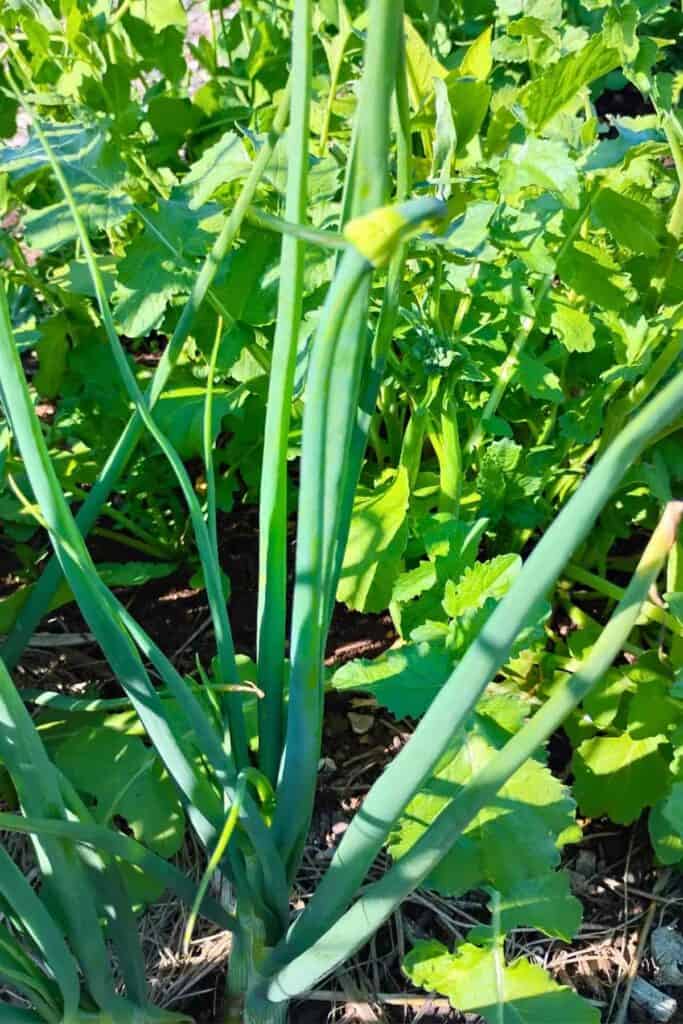
If you grow onions or shallots from seeds, it is unusual that they bolt in the first year, due to their biennial growing habit. If for some reason they do bolt in the first year, it can be due to weather fluctuations, such as a hot period followed by cool weather and back to hot, which can basically tell the onions they went through winter and it’s time to produce seed.
Premature bolting can also be caused by stress. If the onions are stressed due to drought or other environmental pressures, they may produce seed because they may want to procreate in anticipation of their early demise due to the severe hardship. A drought can signal that they are about to die from thirst and so they might try to produce seed early in order to have a chance to reproduce before they die, a hail Mary of sorts.
In the case that you grew onions from sets, it is much more common that they will bolt prematurely than if grown from seeds. Sets are onions, grown in nurseries, and dug up when they are premature and very small still. Then they are dried for storage. Come spring, they are planted and expected to continue their growth to produce full sized onions.
Sometimes these sets have already grown too long in the nursery and will “think” they are in their second year. This will cause them to start bolting before they produce large bulbs, because their programming has switched to year two and says it’s time. Improper storage can cause premature bolting as well. If you plant them in the fall, they might also want to bolt come early spring. Inclement weather can play a part as well.
What To Do When They Bolt
So if your onions or shallots are bolting, they are done growing. Your bulbs will not get any bigger. All the energy of the plant goes into making seeds now and then it gets ready to die.
The pollinators love onion flowers and you could leave some flowers to attract pollinators. However, if you let them flower, your onion bulbs will shrivel up, the leaves will turn yellow, and your onion plant will not be usable anymore.
But once the flowers go to seed, you can collect the seeds if they were not from hybrid onions, and save them for starting seeds in late winter for next year’s crop. Here is where you can learn how to grow your onions from seeds.
You can use the flower stalks and green leaves for chopping into dishes or use one of the other great ideas below.
The bulb will not be usable after the onion or shallot has gone to seed. So if you want to save your bulbs, cut the stalks as soon as you find them and before the onion flower opens. This way the stalk will still be tender and make a delicious food for you. The onion or shallot bulbs will be small and will not store well, but they will still be delicious, so use them soon. Use just as you would use spring onions, or you can freeze, or ferment them.
Onion stalks and leaves can be stored in a plastic or veggie bag in the refrigerator for a few days. Here are some ideas for using onion flower stalks leaves.
How To Use bolted Onion Flower Stalks and leaves
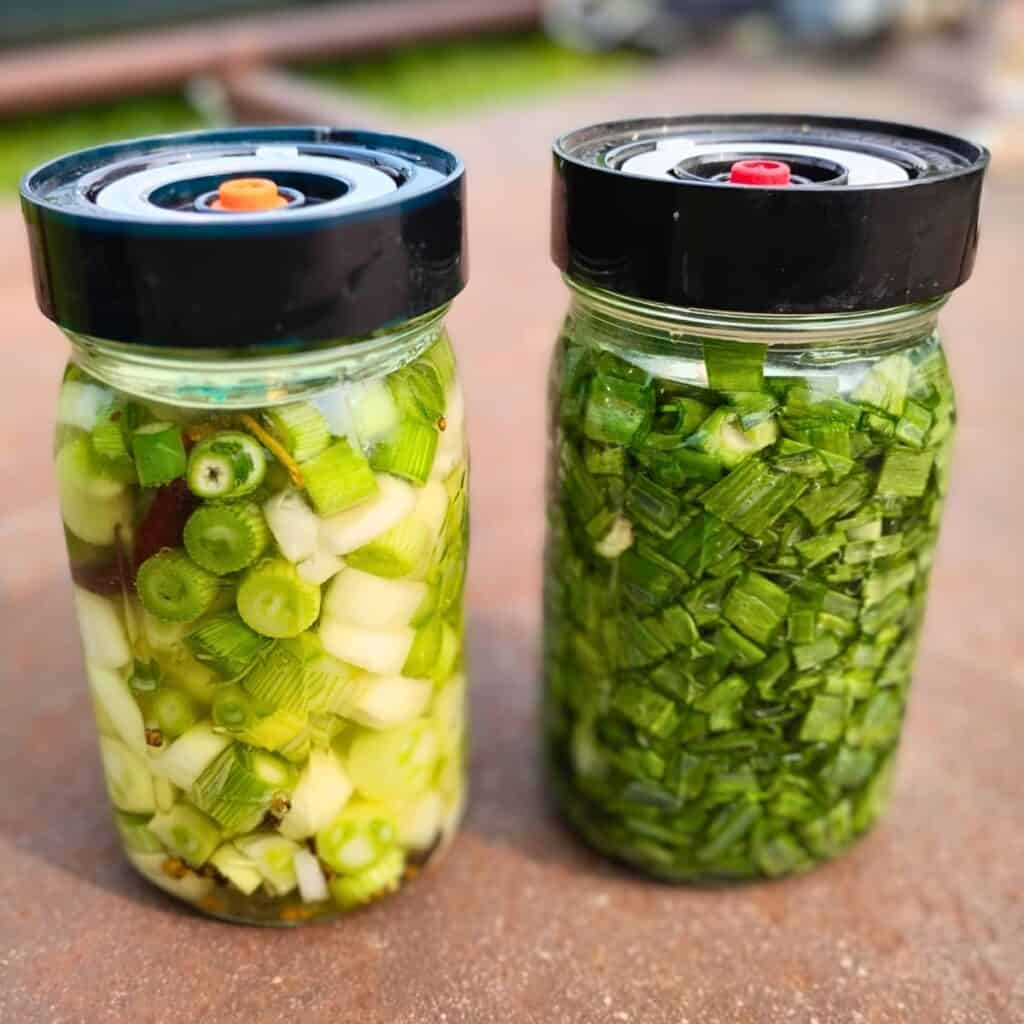
- Use them in stir-fries. Chop into bite sized pieces and stir fry with other vegetables. Use in any stir fry recipes.
- Chop finely and use just like chives in salads.
- Top baked potatoes with thinly sliced onion ‘rings’.
- Make A Spread: Blend into a paste or chop very fine and mix with Quark, Chevre, Cottage cheese, Sour cream, or Mayonnaise for a tasty dip or a spread for sandwiches.
- Make a herbal vinegar by filling a jar half way with chopped onion leaves and stalks. You can add the flower buds too and use them later for garnish in dishes. Top it off with apple cider vinegar. This should infuse for several weeks, then use the vinegar in salad dressings, or drizzle over salads with some olive oil. Use the pickled flower buds as garnish.
- Use in Soup. You can chop them and use them in soups and stews like other greens.
- Make a delicious pesto by using the stalks and leaves together with garlic scapes in any pesto recipe. You’ll find my recipe below!
- Freeze them! Chop into serving size pieces and if you flash freeze them on a baking sheet, then package them, they can be easily used in dishes by just taking a handful out of your bag. Use in soups and stews or other cooked dishes.
- Ferment them! You can ferment onion leaves and flower stalks by using the dry-salted or brine method. I also like to ferment the immature onion or shallot bulbs this way. Personally I like to add the brine. They will be good for at least a year and are delicious on salads, or sandwiches, and the brine is great for flavoring your dressings for your potato salad or drinking a shot as a tonic. If you’re new to fermenting, check out my detailed tutorial on fermenting vegetables for more information and find the master recipes for salt curing and brine fermentation.
Garlic Scape And Bolted Onion Greens Pesto Recipe
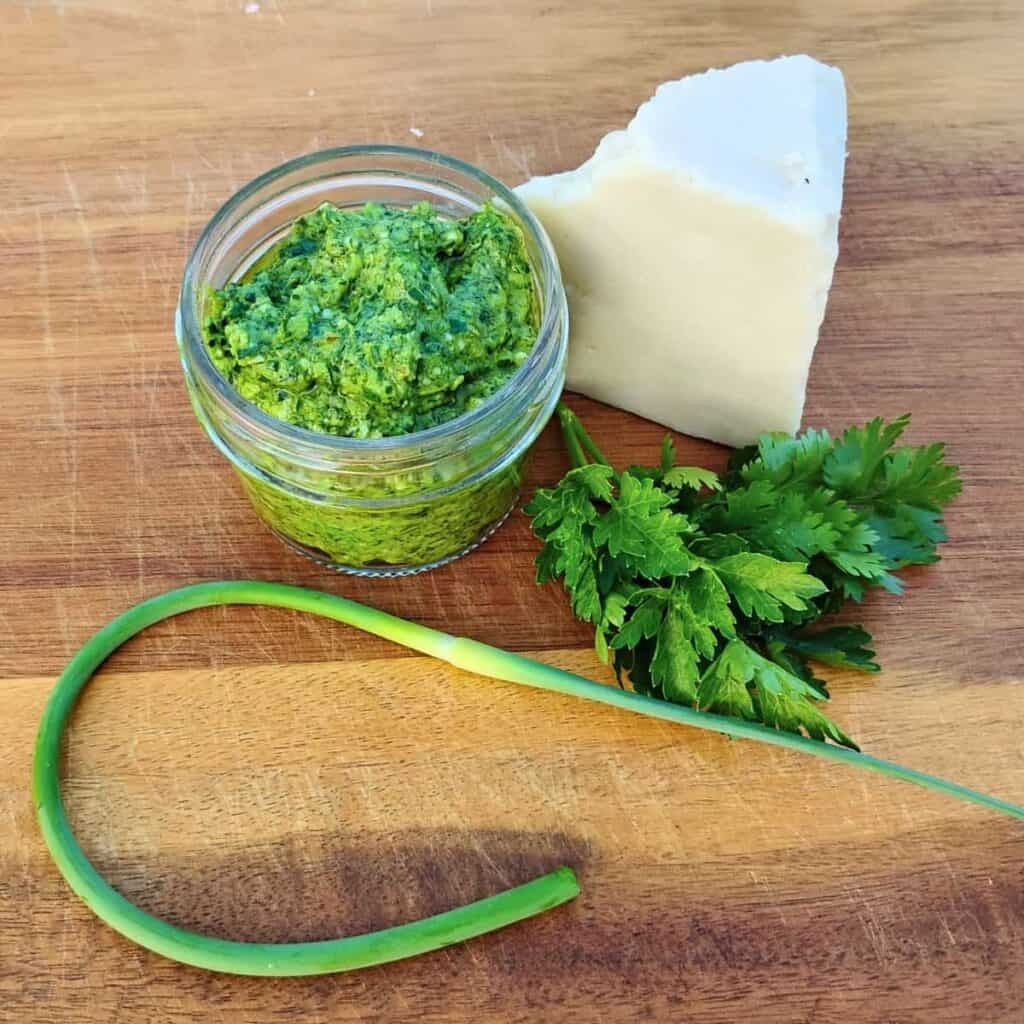
This is a great recipe if your garlic scapes and onions want to flower at the same time. If not, use the garlic scapes and cut a few onion leaves or use bunching onion greens for this recipe. Add any herbs you like in a pesto and a few greens are great too. I love to add some wild greens or weeds for extra nutrition, such as in my wild greens pesto. But you can add any greens you like for a milder pesto.
Equipment
A blender or food processor – I like a food processor, it gives me a slightly grainy pesto, which I prefer. Use a blender for a more smooth pesto.
Silicone spatula – For scraping the sides of your blender while you process the ingredients, and for removing the pesto from the container.
Knife or scissors – I use scissors to cut the fibrous tips off the garlic scape flowers. A knife works best for slicing the scapes. For onion stalks I use either scissors or knife.
Cutting board
Frying pan – For toasting the nuts
Squat shaped 8 oz jars, Optional – Great for storing and freezing Pesto portions. For larger portions I use wide mouth 16 oz canning jars.
Ingredients

I recommend using organic ingredients whenever possible for health reasons!
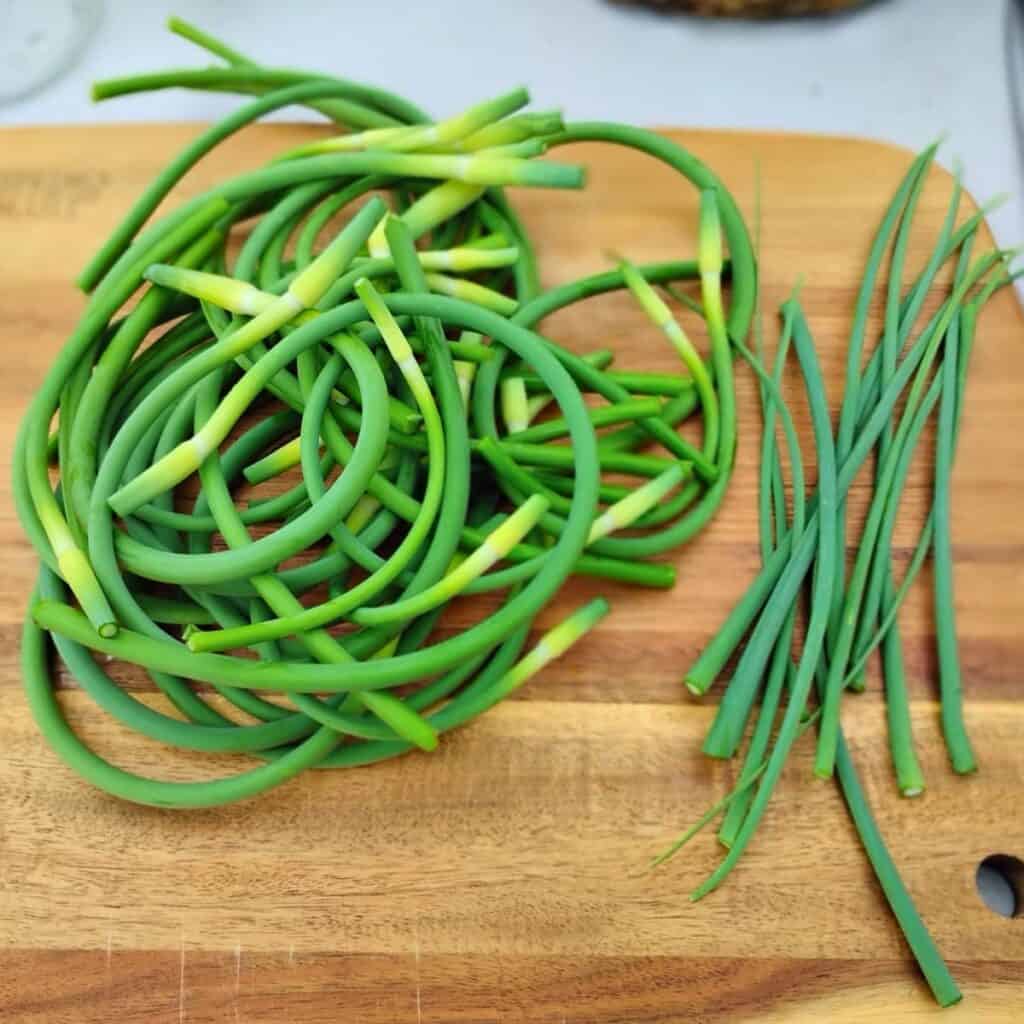
Garlic scapes – Use tender scapes, picked fresh just after it starts to curl. Remove the fibrous tip from the flowers, but you can use the flowers.
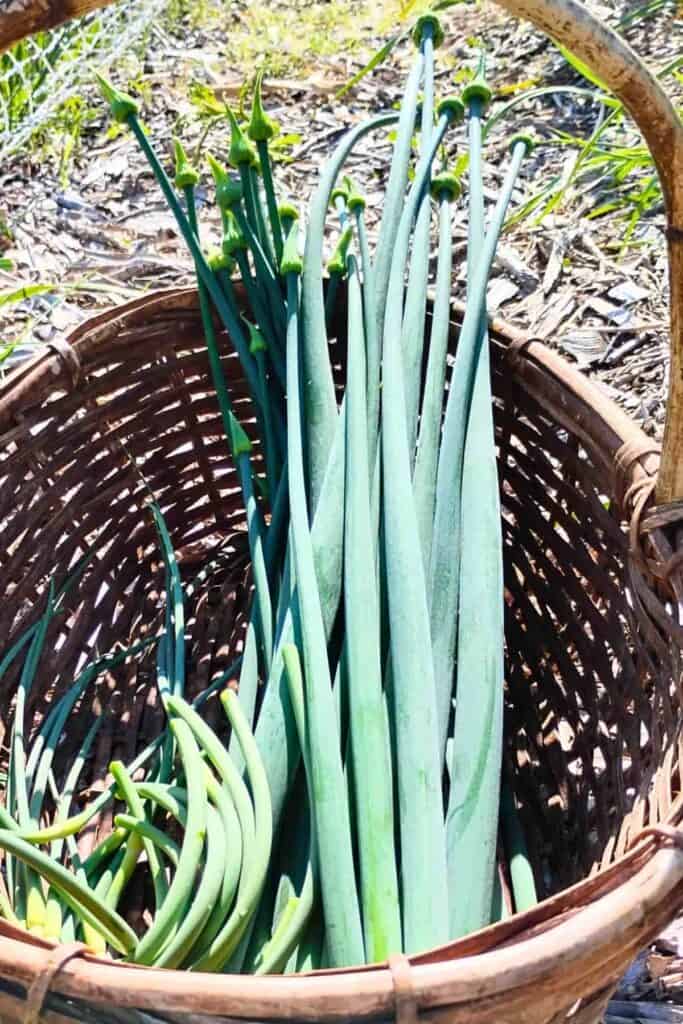
Onion flower stalks – Use the tender stalks and flowers before the flowers start to open.
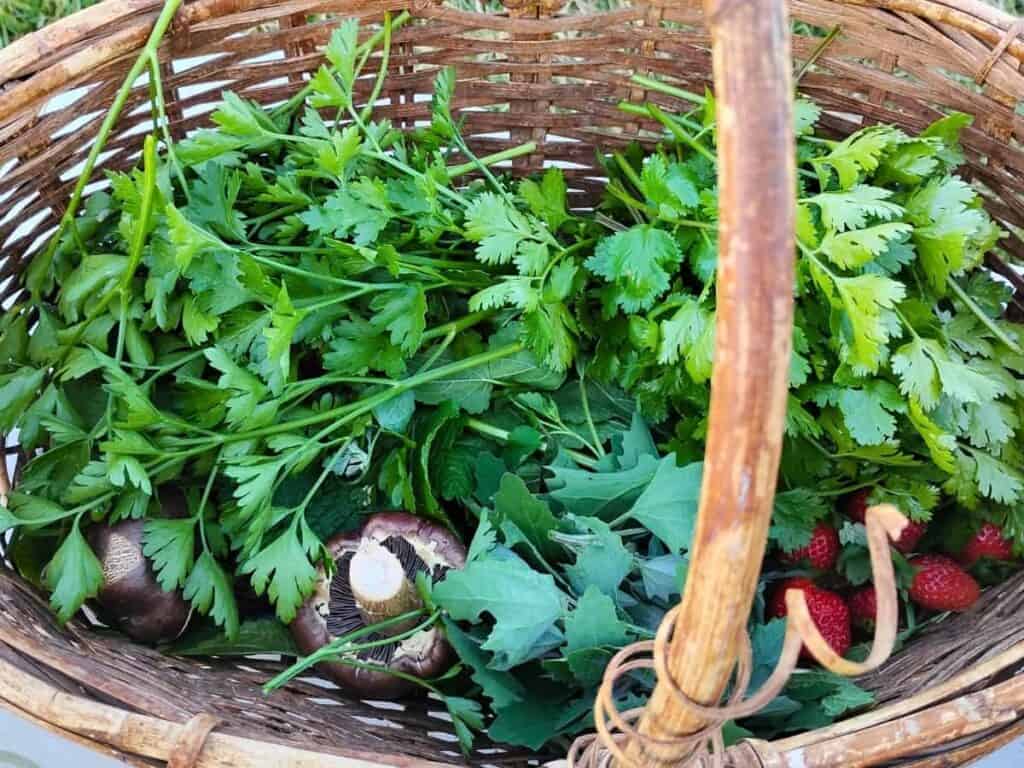
Herbs and greens – Use what you have available, I used lemon balm leaves, parsley, cilantro, and lambs quarters
Walnuts – I used a mix of regular and black walnuts. I like walnuts in this pesto, because they have a bolder flavor than sunflower seeds, which goes well with the bold oniony and garlicky flavor of my pesto today.
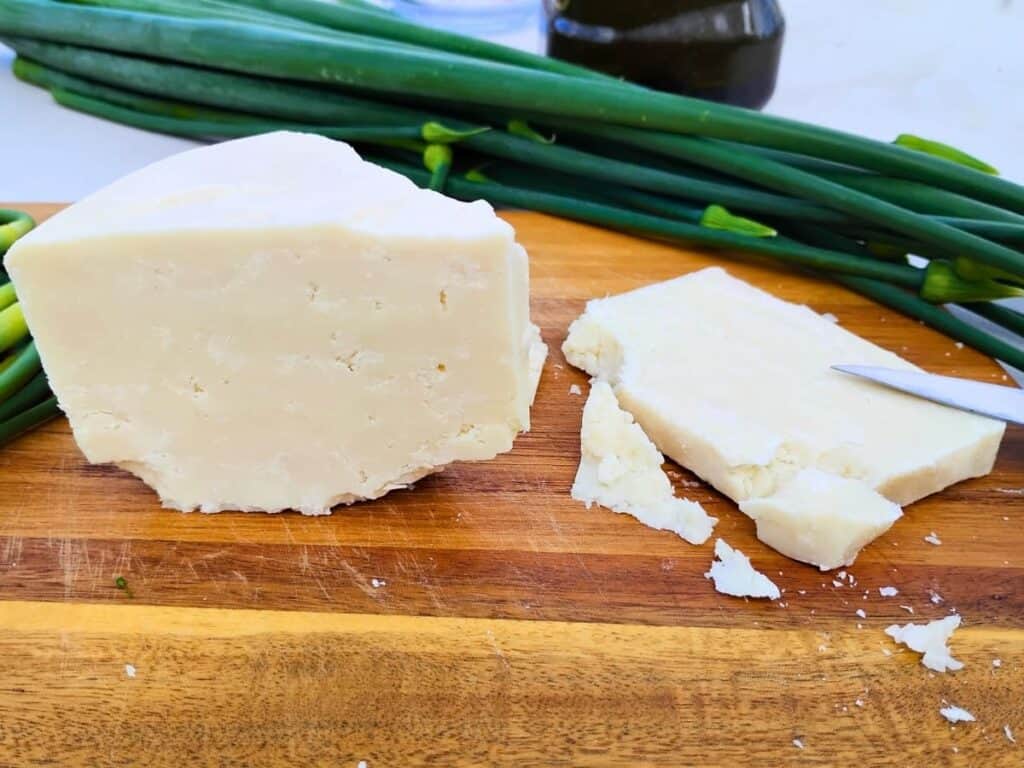
Parmesan cheese – Use any strong flavored hard cheese such as Asiago, Pecorino Romano, or Parmesan. I used my three year old, very dry, aged raw goat’s milk cheddar cheese which has a ton of flavor. It’s very bold and well suited for making pesto.
Sea salt – My favorites are Redmond’s Real Salt, Himalayan Pink Salt, or Celtic Sea Salt. I favor natural, unrefined mineral salts for health reasons, but any salt will do in this recipe.
Extra virgin olive oil – Beware of fake or low grade olive oil and try to avoid commercial seed oils such as canola. They are really bad for you and can cause inflammation in your body. Try to source a quality olive oil that comes from just one source (blends are often low grade oils). Even better, if you can get expeller pressed oil.
Instructions For Garlic Scape And Onion Flower Pesto
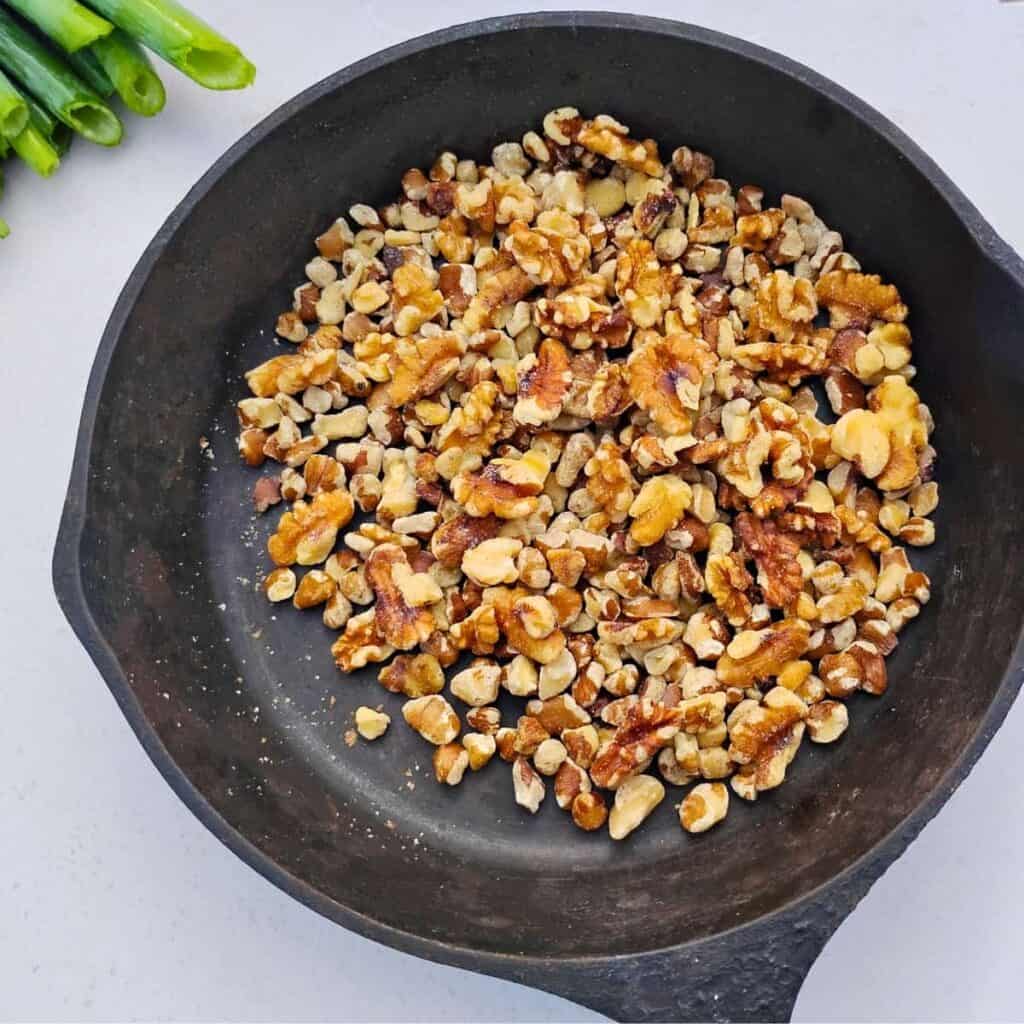
Toast your walnuts or other nuts in a heavy frying pan on medium heat. Keep a sharp eye on them, they go from doing nothing to burning in the blink of an eye once they get hot. Toss a few times while they are on the flame and when it starts to smell fragrant, take them off the heat. If they are not very toasted yet, leaving them in the pan for a few more minutes, this will keep cooking them.
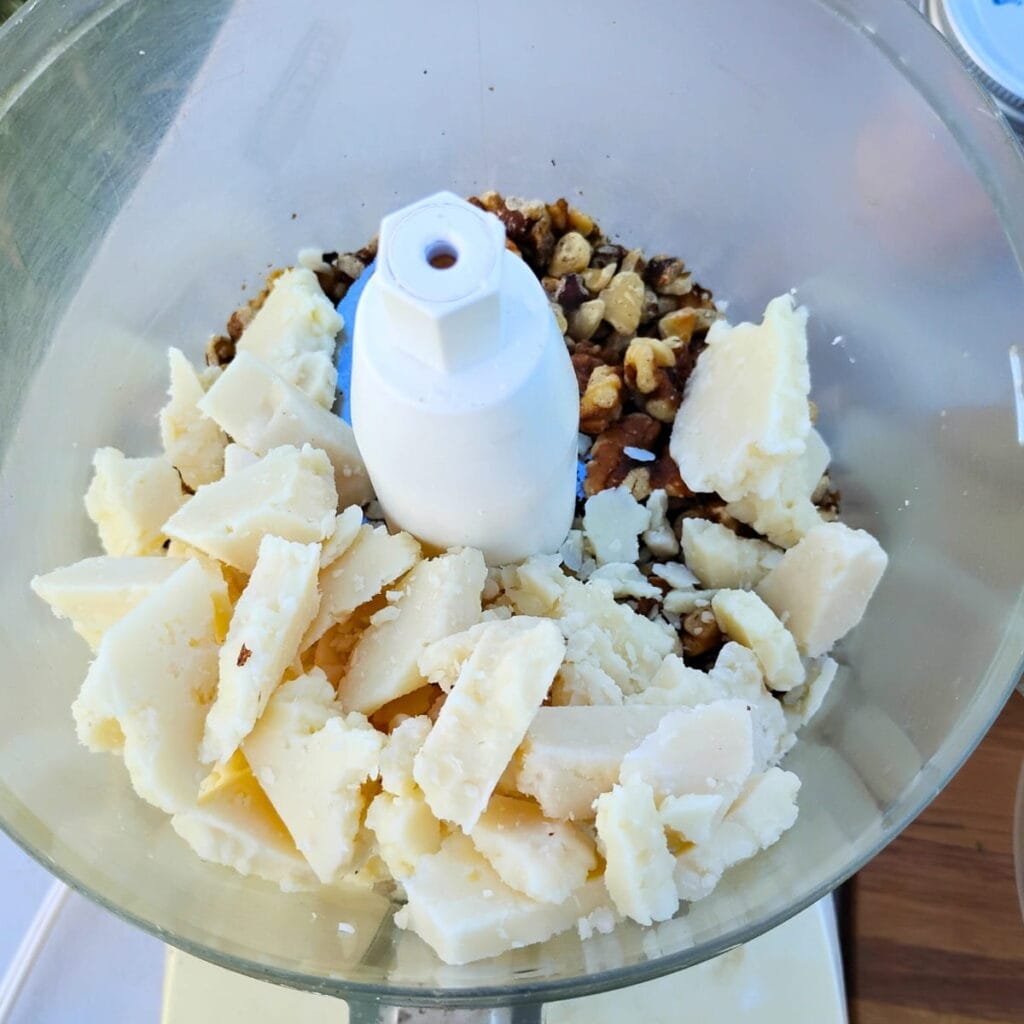
Pour your nuts into the food processor bowl, and once cooled, add the grated or crumbled parmesan cheese.
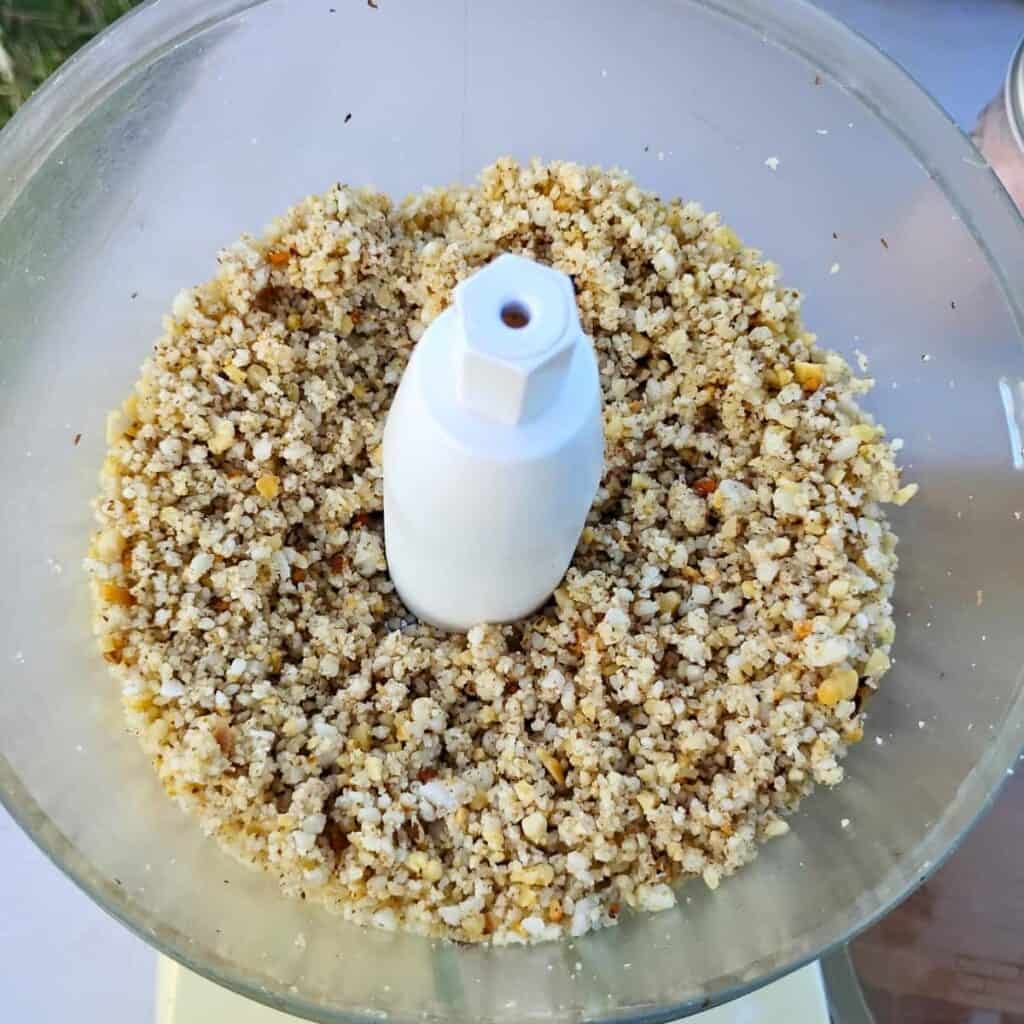
Process on high for a few seconds.

Chop your herbs into smaller chunks. Place into the food processor bowl. You may need to pulse a few times to chop up part of the herbs before you have room to add the rest. Process until you have a smooth paste.
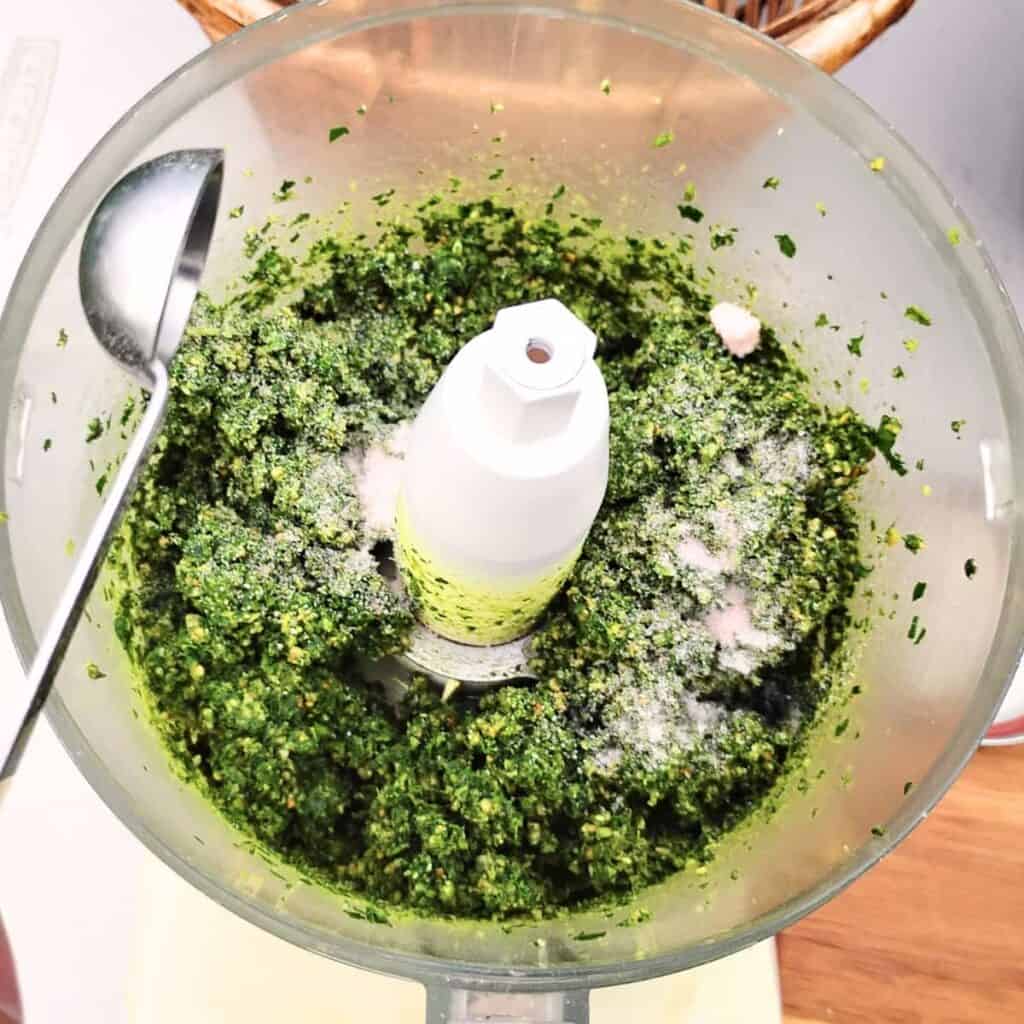
Add the salt.
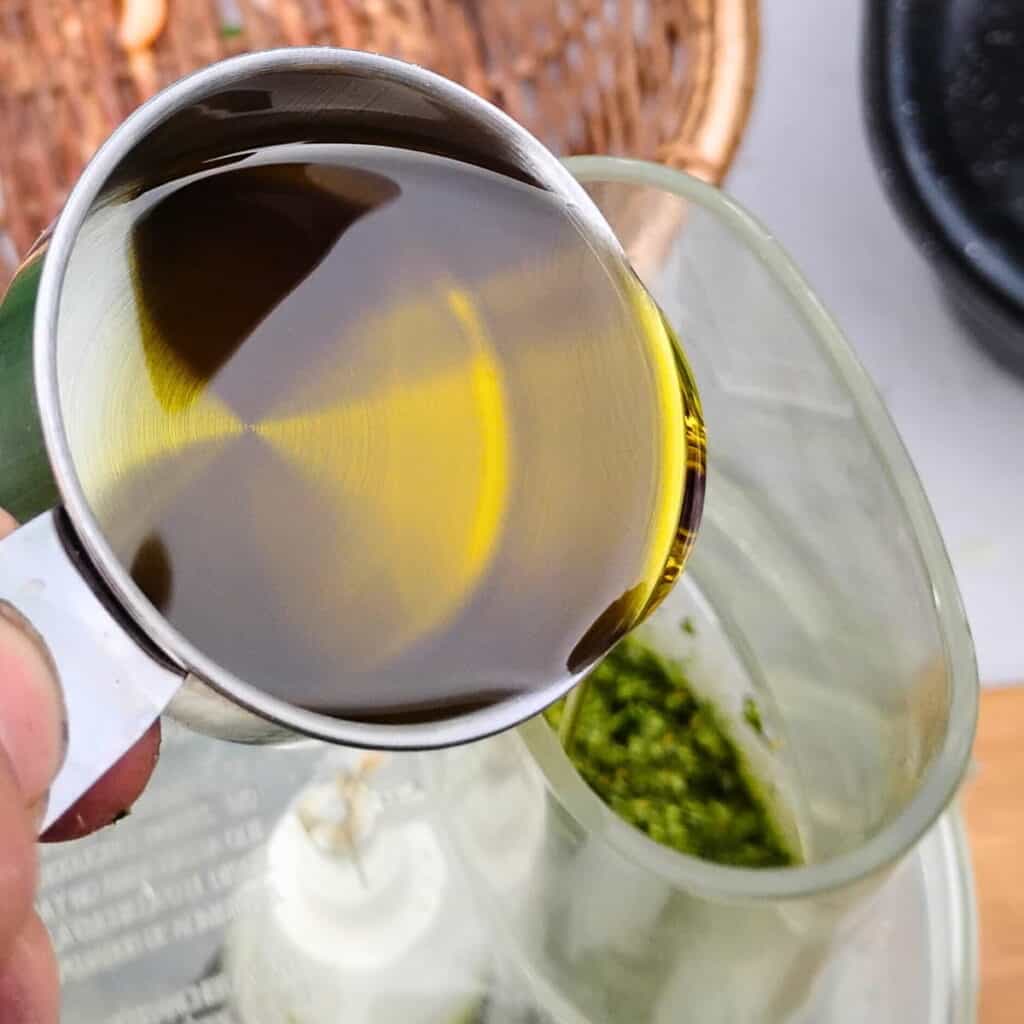
Turn on the processor and while it runs, slowly drizzle in the olive oil. Process till well combined and you have a nice smooth paste. Scrape the sides with a spatula a time or two between pulses.

Now you have an awesome pesto that you can use like any pesto. If you want to store it, put it into a jar and pour a small amount of olive oil over the top to prevent browning. You can keep it in the refrigerator for a week, or freeze it for 4-6 months.
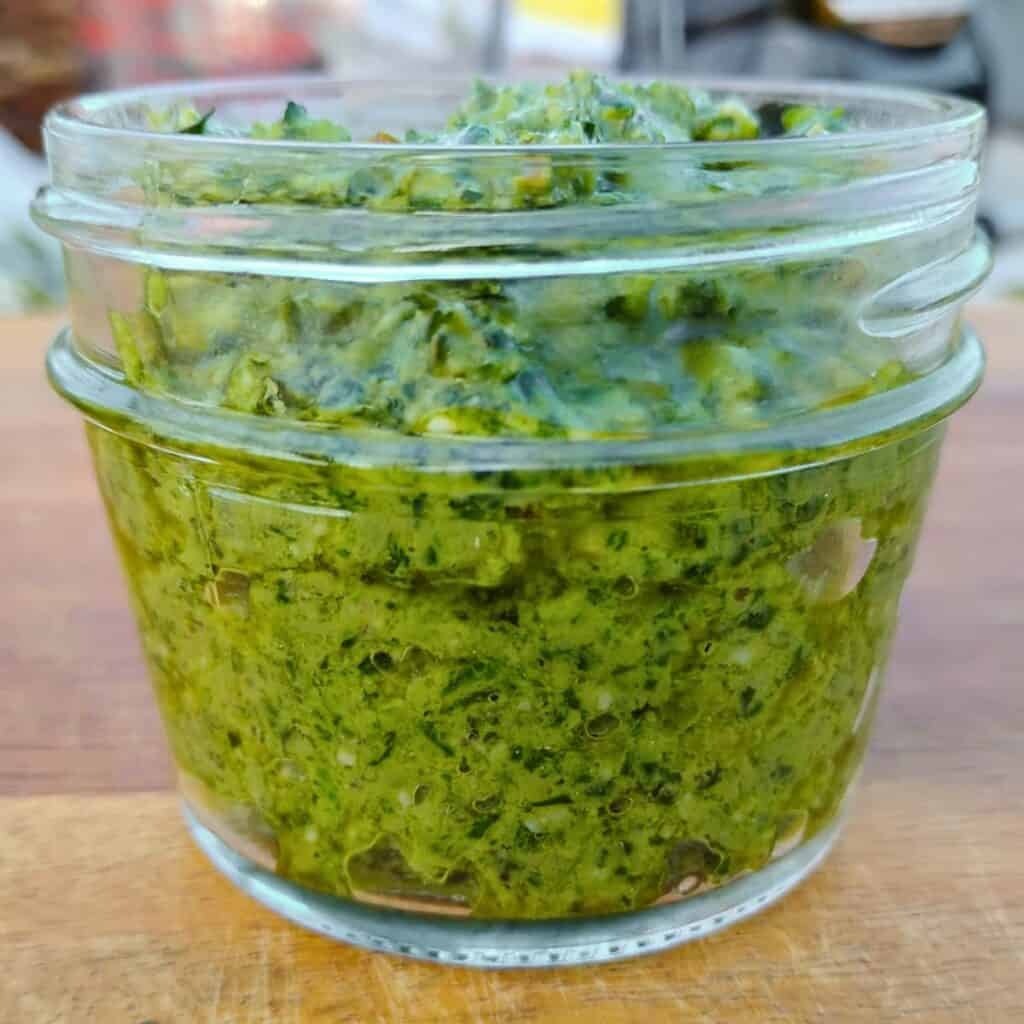
How to use the pesto
- Toss with your favorite pasta
- Toss with grain or rice for a rice bowl
- Top baked potatoes
- Top sliced meat roast
- Put a pad on poached fish (I love to add lemon balm leaves to the pesto for this or a little preserved lemon paste or lemon zest and juice)
- Serve in a jar as a dip on a charcuterie board. This is just really great with cheese.
- Really amazing on egg dishes such as omelette, or with scrambled eggs.
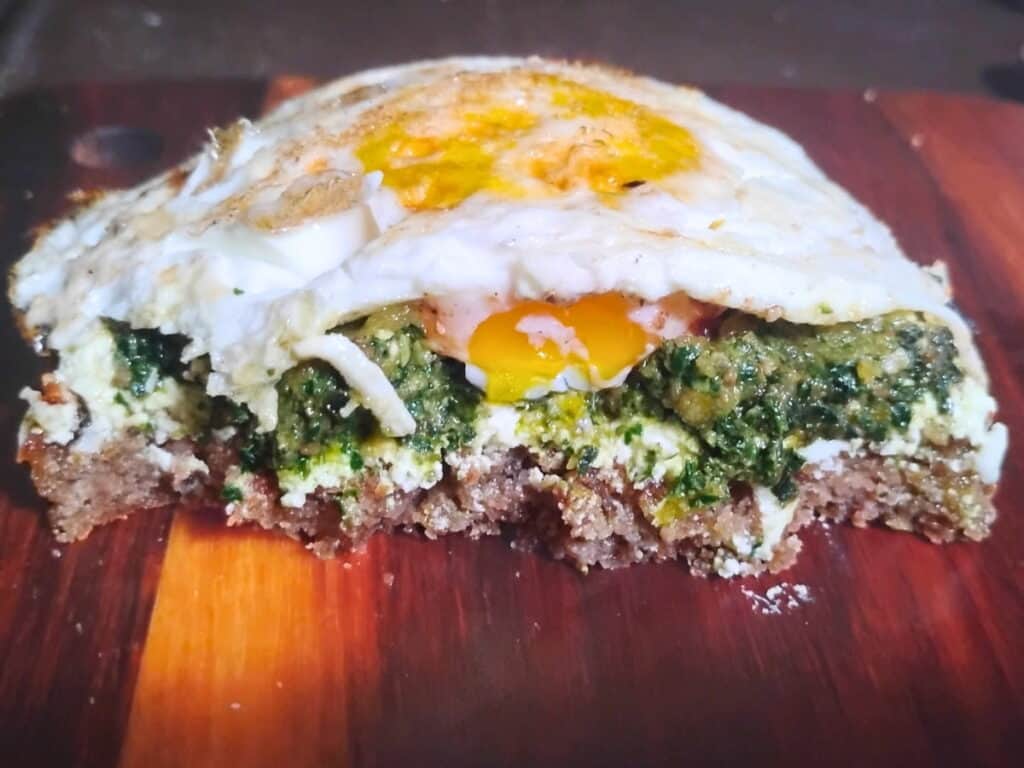
- My favorite breakfast sandwich is a slice of toasted sourdough bread topped with chevre or quark cheese, cantaloupe hot sauce and a thick layer of pesto (Sometimes I mix all of the above and put it in a jar as an easy sandwich spread). This all gets topped with a couple of medium fried eggs. Really messy to eat and incredibly delicious! Just had this a minute ago, 😁Yumm!
- To tell the truth, it’s a superb treat eaten with a spoon right out of the jar.
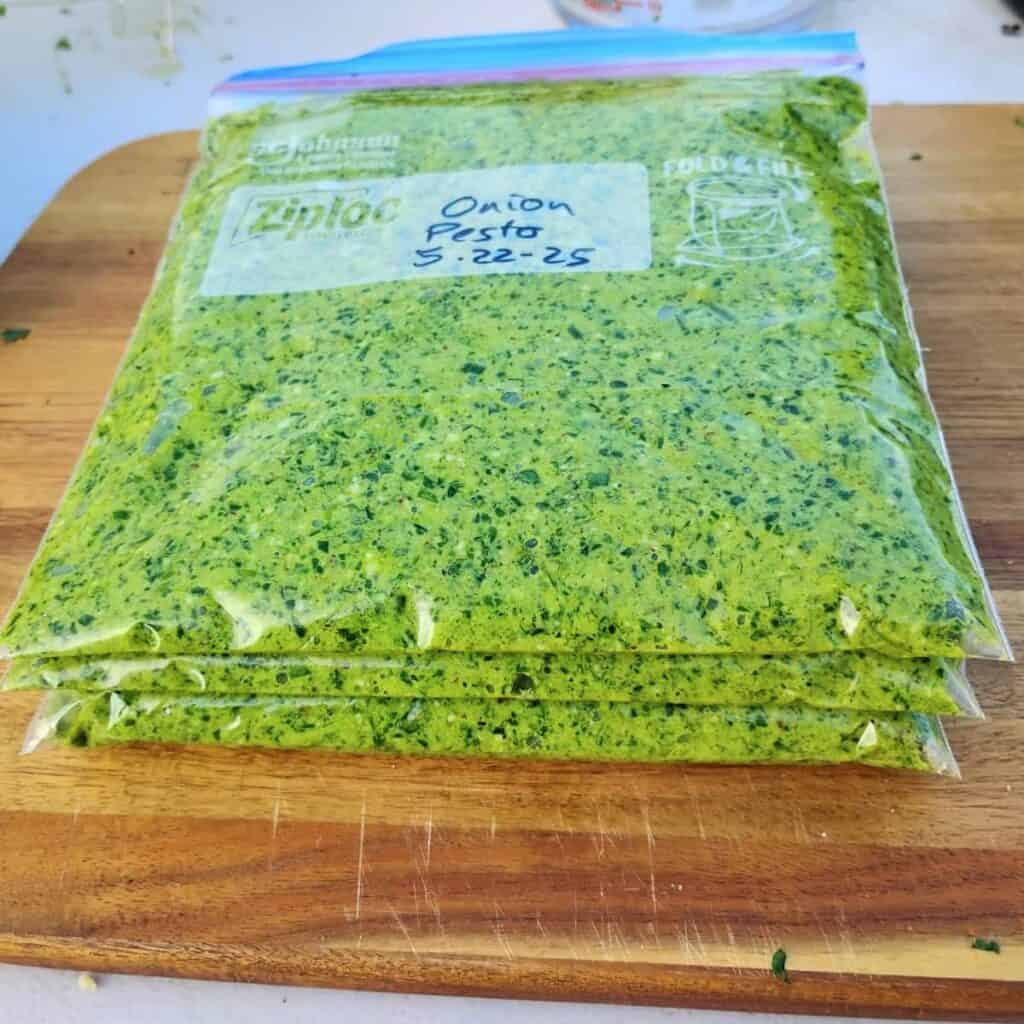
I’ll let you come up with some ideas too. I could keep writing, but you get the idea, it’s good on just about everything! I love pesto and when I made this one, I doubled the recipe and put a couple of bags in the freezer, flattened, so I can break off chunks when I want to have some. You could also freeze it in silicone muffin baking forms and transfer to a freezer bag, small mason jars, or even ice cube trays for extra small portions.
Enjoy Your Abundant Harvest Of Garlic Scapes and Embrace The Unfortunate Event Of Your Bolted Onions!

I hope you found some great ideas for using your bolted onion flower stalks and garlic scapes. I hate it when onions do that to me, but it happens and so I like to make the best of it. This pesto is the most delicious way I know to use them and it makes me feel appeased at the little twist that nature played on me. You can see that onion flower stalks and garlic scapes provide some great ingredients for delicious meals, sides and condiments.
Let me know if your onions or shallots ever bolted on you prematurely! This year was my first because I planted shallot sets instead of seeds, but I am happy to have the bountiful greens and tasty immature shallot bulbs to make pesto and to ferment. Leave me a comment if you have questions and I’d totally appreciate a ⭐⭐⭐⭐⭐ rating if you like my pesto recipe or this article!
And please don’t forget to subscribe for more great recipes and homestead tips and ideas. I’m always adding new content. Click here to get my Food For Life Garden News today so you don’t miss any new posts.
Other recipes you might like
How To Grow Garlic – What to do to get big and healthy garlic bulbs. When and how to plant and harvest.
Fermented Garlic Scapes – Preserve your extra garlic scapes and gain a lot of health benefits by fermenting them. They make delicious, tangy pickles with lots of uses.
Foraged Wild Weeds Pesto Recipe – Make a delicious Pesto with dead nettles and other wild weeds with this guide to foraging wild greens.
Mushroom Risotto – delicious gourmet flavored rice dish that’s easy to make. Serve this pesto with it for a superbly delicious dinner!
How To Grow Bigger Onions – A complete tutorial on growing onions from seed to storage.
25 Essential Herbs To Plant – Start your home apothecary garden with these 25 powerful allies for your health. Learn their benefits, how to grow them and where to source them.
Fermented Garlic and Honey – A powerful combination of two all-star infection and sickness fighters. Make this easy remedy today and be ready for cold and flu season!
Fermented Garlic – Lacto-fermented garlic paste is kind of a special food. It’s the ultimate convenience food and health supplement. But besides that, it gets better as it ages. Just like a fine wine.
Fermented Onions – Keep some onions ready to use on Sandwiches or to put on your salads. Zesty or plain, onions are so tasty when fermented!
Forage Purple Dead Nettle And Make A Tincture – Capture the many health benefits of purple dead nettles in a tincture for year round use.
Homemade Apple Cider Vinegar – This lovely vinegar is made from apple scraps, not the actual apple cider. But it is just as effective, easier to make and uses all those leftover apple scraps or ugly apples.
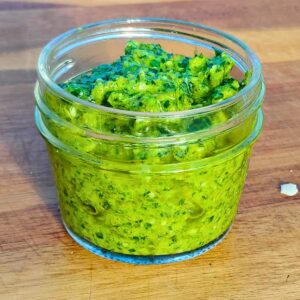
Garlic Scape And Onion Flower Pesto Recipe
Equipment
- A blender or food processor – I like a food processor, it gives me a slightly grainy pesto. Use a blender for a more smooth pesto.
- Silicone spatula
- Knife or scissors
- cutting board
- Frying Pan – For toasting the nuts
- Squat shaped 8 oz jars, Optional – Great for storing and freezing Pesto portions. For larger portions I use wide mouth 16 oz canning jars.
Ingredients
- 1 cup Garlic scapes, chopped – Use tender scapes, picked fresh just after they start to curl. Remove the fibrous tip from the flowers, but you can use the flowers.
- 3 cups Onion flower stalks, chopped – Use the tender stalks and flowers before the flowers start to open.
- 3 cups Herbs and greens, chopped – Use what you have available. I used lemon balm leaves, parsley, cilantro, and lambs quarters.
- ½ cup Walnuts – I used a mix of regular and black walnuts. I like walnuts in this pesto, but you can use any nuts.
- ¾ cup Parmesan cheese – Use any strong flavored hard cheese such as Asiago Pecorino Romano, or Parmesan.
- ½-1 tsp Sea salt – My favorites are Redmond's Real SaltHimalayan Pink Salt, or Celtic Sea Salt.
- ¾ cup Extra virgin olive oil
Instructions
- Toast your walnuts or other nuts in a heavy frying pan on medium heat. Keep a sharp eye on them, they go from doing nothing to burning in the blink of an eye once they get hot. Toss a few times while they are on the flame and when it starts to smell fragrant, take them off the heat. If they are not very toasted yet, leave them in the hot pan for a few more minutes, this will keep cooking them.
- Pour your nuts into the food processor bowl, and once cooled, add the grated or crumbled parmesan cheese.
- Process on high for a few seconds.
- Chop your herbs into smaller chunks.
- Add the herbs. You may need to pulse a few times to chop up half of the herbs before you have room to add the rest. Process until you have a smooth paste.
- Add the salt.
- Turn on the processor and while it runs, slowly drizzle in the olive oil. Process till well combined and you have a nice smooth paste.
- Now you have an awesome pesto that you can use like any pesto. If you want to store it, put it into a jar and pour a small amount of olive oil over the top to prevent browning. You can keep it in the refrigerator for a week, or freeze it for 4-6 months.
Notes
How to use the pesto
- Toss with your favorite pasta
- Toss with grain or rice for a rice bowl
- Top baked potatoes
- Top sliced meat roast
- Put a pad on poached fish (I love to add lemon balm leaves to the pesto for this or a little preserved lemon paste or lemon zest and juice)
- Serve in a jar as a dip on a charcuterie board. This is just really great with cheese.
- Really amazing on egg dishes
- My favorite breakfast sandwich is a slice of sourdough bread topped with chevre or quark cheese, cantaloupe hot sauce and a thick layer of pesto (Sometimes I mix all of the above and put it in a jar as an easy sandwich spread). This all gets topped with a couple of medium fried eggs. Really messy to eat and incredibly delicious! Just had this a minute ago, 😁Yumm!
- To tell the truth, it’s a superb treat eaten with a spoon right out of the jar.
Enjoy Your Abundant Harvest Of Garlic Scapes and Embrace The Unfortunate Event Of Your Bolted Onions or Shallots!
I hope you found some great ideas for using your bolted onion flower stalks and garlic scapes. I hate it when onions do that to me, but it happens and so I like to make the best of it. This pesto is the most delicious way I know to use them and it makes me feel appeased with the little twist that nature played on me. You can see that onion flower stalks and garlic scapes provide some great ingredients for delicious meals, sides and condiments.Pin This Post

Shop This Post
Food processor
Blender
Silicone spatula
Frying pan
16 oz canning jars
Squat shaped 8 oz jars
Redmond’s Real Salt
Himalayan Pink Salt
Celtic Sea Salt

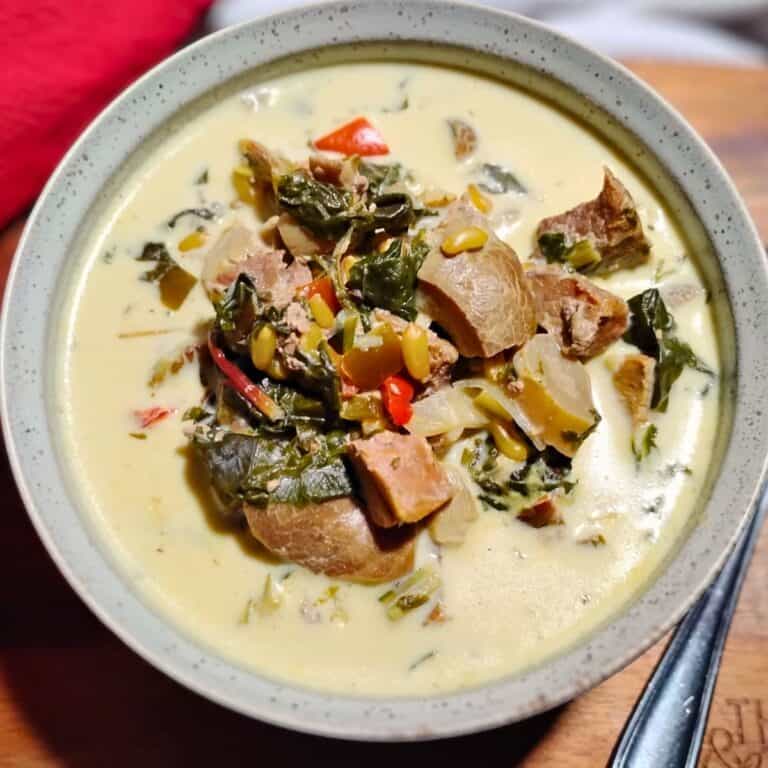
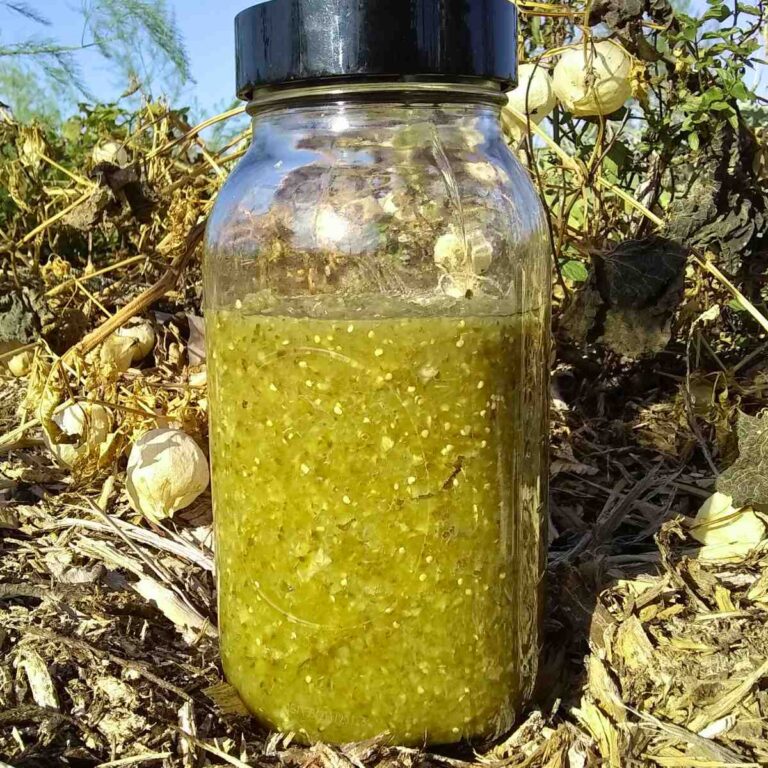
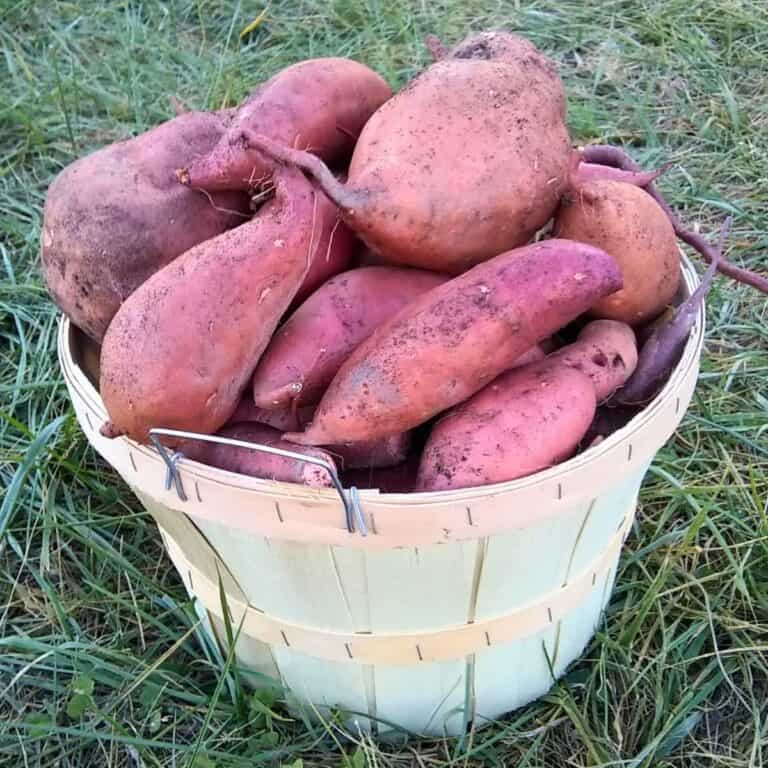
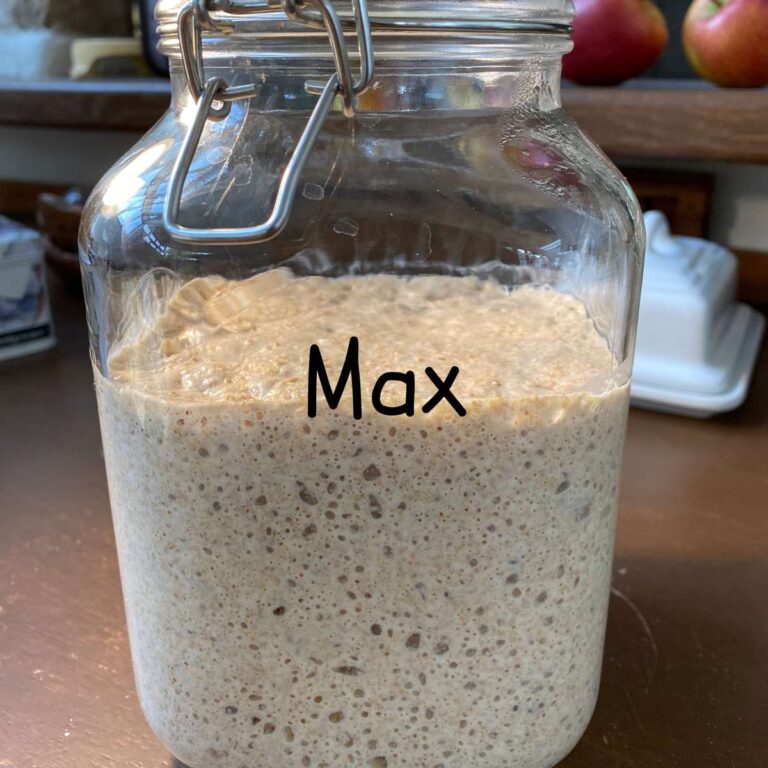

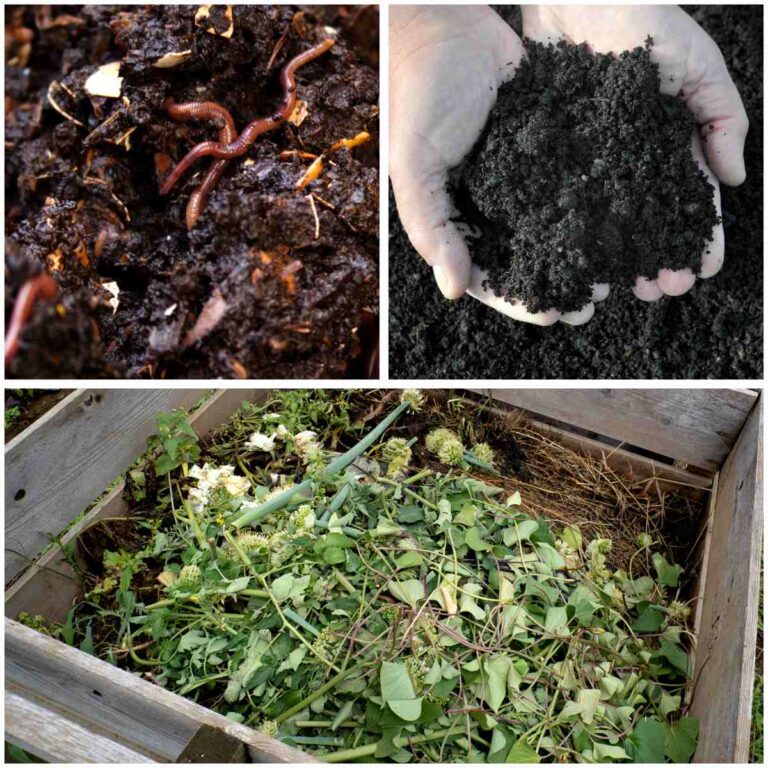
Garlic scapes are such a great spring treat. They are so tasty, sauteed or grilled, but there is much more you can do with them and I love garlic scapes in pesto. So delicious! If you have any questions, you may ask in the comments here and I will post an answer as soon possible. Thanks for visiting this page!
What great ideas! I’m always trying to figure out how to use or preserve everything from the garden before it goes bad. So helpful!
Thank you very much for your kind comment, Annabelle! I’m so glad that you found this helpful!
These are all such wonderful ideas!! I’m impatiently waiting for my garlic to produce scapes to try your pesto recipe!! I have never have onions bolting, but I always save all the onion greens and use them in place of green onions 🙂
That’s great, Marta! This was my first with bolted shallots. Normally I use the green onions, but those onion stalks were really kind of nice to have for a change, very ‘meaty’. I hope you love this pesto as much as I do!
Ohhh I love everything with garlic and onion. You have so many ideas. I feel like I could spend hours on your site just soaking up all of the yummy recipes and tips!
Thank you so much for your kind comment, Alisha, I appreciate it! I’m glad you enjoy my articles!😊
Such a helpful post! I never know what to do with garlic scapes or bolted onions, these ideas are so practical and creative. Can’t wait to try a few!
I’m so glad you found this helpful, Emily, and I hope you love these recipes!
This is super thorough and awesome! Thanks for sharing all this info, definitely pinning!
Thanks so much, Priscilla. Glad you enjoyed my article!
So yummy. We just harvested our garlic scapes last night and used some in parmesan chicken and a lemon – garlic scape sauce over noodles.
This was a ver informative article on how to use garlic scapes and harvest them properly!
That sounds like a super delicious dinner. Thanks so much for sharing!
Superb article showing just how much good food gets wasted by mainstream ag practices. Having worked in that industry, it just blows your mind how much food gets wasted on the farm because the supermarkets make ludicrous judgement calls on imperfect produce, then more is wasted by careless rushed handling at the wholesale markets, then even more gets tossed by the supermarkets directly.
I hope more people wise up to your delicious, thrifty ideas, Heidi. Great job 🙂
Thank you! I agree with you. And very often the most nutritious parts are the ones that get discarded, like carrot greens, beet greens, vegetable and fruit peels and so on. Thank you for your comment, Peter!